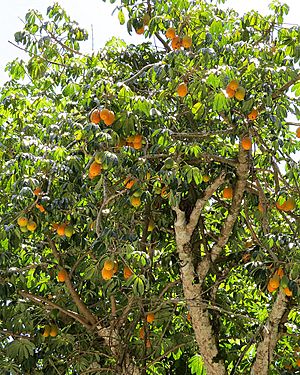Jacaratia spinosa facts for kids
Quick facts for kids Jacaratia spinosa |
|
|---|---|
 |
|
|
bark
leaf
fruit
seeds
|
|
| Scientific classification | |
| Genus: |
Jacaratia
|
| Species: |
spinosa
|
The yacaratiá tree (scientific name: Jacaratia spinosa) is a fascinating plant that belongs to the papaya family. It's also known as wild mango or by its Brazilian names, mamoeiro-bravo and mamãozinho. In Argentina, it's simply called the yacaratiá tree.
You can find this tree growing in the warm, dry forests of central and southern Mexico, Nicaragua, and El Salvador. The stem of the yacaratiá tree is special because it's used to make candy. Its fruit is also a tasty treat for many animals, like monkeys and birds!
Contents
What the Yacaratiá Tree Looks Like
The yacaratiá tree is a type of tree that loses its leaves every year, just like some trees do in autumn. It has a fairly open and narrow shape at the top, called its crown. This tree can grow quite tall, reaching up to 15 meters (about 50 feet) high.
One interesting feature of the yacaratiá tree is that its trunk is covered with short, strong, cone-shaped spines.
Who Eats the Yacaratiá Fruit?
The fruit of the yacaratiá tree is a popular food source for many different animals in its habitat. These animals include:
- Lowland tapirs
- Brown howler monkeys
- White-lipped peccaries
- Collared peccaries
- White-eared opossums
- Argentine black and white tegus (a type of lizard)
- Southern muriqui (a large monkey)
- Humans
- Various birds
Yacaratiá as Food
The fruit of the yacaratiá tree can be eaten either raw or cooked. If you want to eat it raw, you need to score (make cuts in) the skin for a while. This helps to release a lot of a milky liquid called latex.
Edible Wood: A Special Treat
What's truly unique about the yacaratiá tree is that its wood can actually be eaten! It's considered a special treat in Argentinian restaurants. People prepare the wood by soaking it in honey or syrup. You can even find it in chocolate bonbons or in flavored jams mixed with a bit of sawdust.
The wood itself is soft and has a fibrous texture. People who have tried it say it tastes similar to chestnuts. Most wood is hard for humans to digest because it contains a lot of a substance called lignan. However, yacaratiá wood is different. It's only about 10% cellulose, and most of the rest is water with very little lignan. This is because the cells in this tree's wood have large spaces inside them that store water, making it much easier to eat.
Yacaratiá in Farming and Forests
The yacaratiá tree is a great example of a "pioneer species" in agroforestry (a farming method that includes trees). This means it's one of the first types of trees to grow in an area that has been cleared or disturbed. It grows very quickly, which makes it helpful for restoring forests or starting new plant growth.
See also
 In Spanish: Yacaratiá para niños
In Spanish: Yacaratiá para niños





